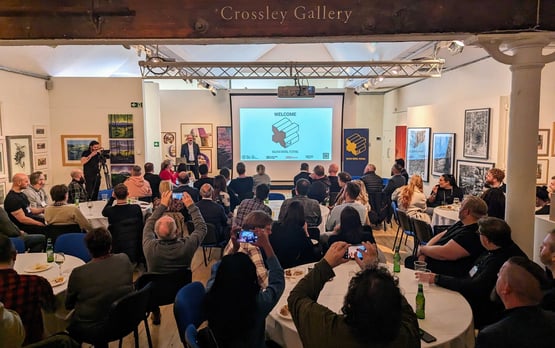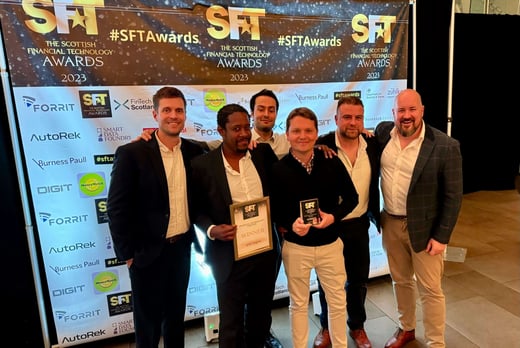Community
How we helped Sustainable Fashion Scotland develop a new website
13 August 2021 • 4 min read
.png?width=1920&height=836&name=How%20we%20helped%20Sustainable%20Fashion%20Scotland%20develop%20a%20new%20website%20(1).png)
At AND, it's important that the work we do has an impact. As an organisation, we want to leave a legacy in the communities in which we work, and as individuals we all want to be able to support initiatives and projects that mean something to us. That's why AND offers all employees something called 'innovation days'. These are opportunities for members of the team - in any role and from any background - to work on projects that matter to them.
There is lots of great work being done across the organisation, but in this post we're going to spotlight work done by three members of our Edinburgh office (or Club), Somerville.
Developers Rachel Walker, Barbara Sasfy, and Taliah Horner worked together on a project with Sustainable Fashion Scotland, a charity that is working to both encourage consumers to shop sustainably and support independent designers to bring their work to the market.
We spoke to Rachel about the work they did together. As you'll see, not only was it a great opportunity to contribute and support a brilliant organisation, it was also an opportunity to learn new skills and try new ways of working.
Background: pitching to Sustainable Fashion Scotland
Hi Rachel! What is Sustainable Fashion Scotland? How did you connect with them?
Rachel Walker: Sustainable Fashion Scotland (SFS) is a campaign and community group across Scotland whose mission is ‘to connect the community and be the go-to source for all things sustainable fashion in Scotland.’
Mairi Lowe, one of the founders of SFS, has been a friend of mine for a number of years. I was looking for an innovation project to help with my upskilling at the time when Mairi had started talking to me about how SFS was looking to make a website. I thought it would be a good fit for an innovation project, so we had a conversation about what they would want from the site and I then pitched the idea.
What did they need? Why was it important to them?
RW: They were looking to make a website. At the time they were solely working from social media feeds and didn’t have any central hub for all of their information or any easy way to share information on all of their different activities. They wanted to have a hub for everyone involved in sustainable fashion in Scotland to go to and connect.
Getting started: capturing requirements
What was the first step? How did you get started?
RW: First I talked to Mairi about what she would want from the project. I put together a deck looking at the plans and they had a vision board and statement pre-made. They had done some research on what those involved with them would want in a website. Mairi had drawn out a basic version of what a website would look like. We used these to put some designs together on Figma.
What was the process of capturing requirements?
RW: These were somewhat loose. We had a very good idea of what they wanted from the discussions and vision that they had. We used this to create a backlog, roadmap and user stories checking in with these at regular intervals.
Technology and collaboration
How technical was the SFS team? Did you have to change the way you’d normally work or talk to bring them in on the project?
RW: Mairi was our primary contact within SFS as well as Liisa Lehtinen. They had a good understanding of standard web technologies, Mairi had done significant work with basic web design before. We talked through the technologies we were planning to use and any more technical aspect although the largest brunt of the work was analysis which when shown to them should have been clear to them anyway.
What did the project involve? Talk us through the work you did.
RW: First, we created Figma Designs. Taliah and I created designs, and SFS chose the ones they preferred.
We then created a set of artefacts that acted as the blueprint for the work we would do. They included:
- An opportunity Model
- A set of OKRs
- An impact/Effort Graph
- A basic Roadmap
- Personas
- A user Story Map
- A sitemap
- User Journeys
The tech stack
What technologies did you use? Why did you choose them?
RW: Barbara had a lot of impact on what tech we used. She had been wanting to upskill in some tech including Gatsby, Contentful, and Material UI for her work with clients. Fortunately, these seemed like good fits for the project as well, so we went forward with those.
How did you equip the SFS team with the knowledge needed?
RW: We had multiple meetings with SFS updating them on progress and talking about what their future plans were and what they needed from us.
An opportunity to learn and leave a legacy
What did you learn from the process?
RW: I learnt loads throughout the project. I hadn’t made any artefacts in ‘real’ settings before so being able to go through and put together all of those was a huge learning experience. I learnt how to put together personas, user story maps and user journeys and got feedback from senior analysts in the club. I hadn’t done very much in Figma before either so that was a take-away as well as technical skills with Material UI and Contentful.
Why should ANDis get involved with these kinds of projects?
RW: These are great projects to be involved in. You can get great experience in a language or an analyst skill you want to improve on in a ‘safe’ environment. You can do something good for the world and it’s hard evidence for a future progression.
Learn more about AND Digital's community work.
Join the team: search all our job vacancies.



